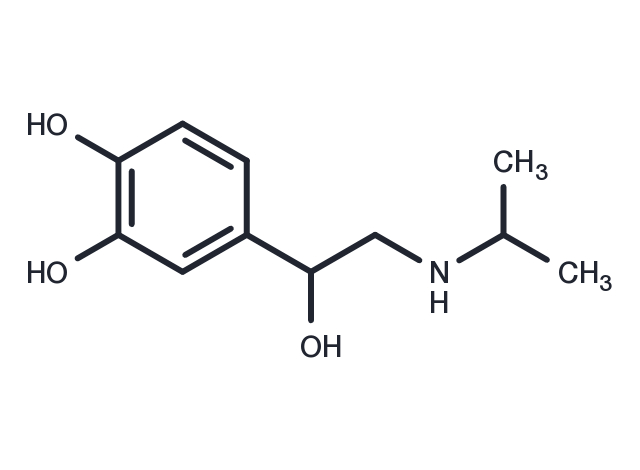Powder: -20°C for 3 years | In solvent: -80°C for 1 year


Isoproterenol (Norisodrine) is a non-selective and orally active β-adrenoceptor agonist.Isoproterenol is a potent peripheral vasodilator and bronchodilator.Isoproterenol can be used in the study of bradycardia and bronchial asthma for the treatment of heart block, bradycardia.

| Pack Size | Availability | Price/USD | Quantity |
|---|---|---|---|
| 1 mg | Inquiry | $ 350.00 | |
| 5 mg | Inquiry | $ 828.00 | |
| 10 mg | Inquiry | $ 1,130.00 | |
| 25 mg | Inquiry | $ 1,590.00 | |
| 50 mg | Inquiry | $ 2,130.00 |

| Description | Isoproterenol (Norisodrine) is a non-selective and orally active β-adrenoceptor agonist.Isoproterenol is a potent peripheral vasodilator and bronchodilator.Isoproterenol can be used in the study of bradycardia and bronchial asthma for the treatment of heart block, bradycardia. |
| In vitro |
Isoproterenol (300 nM, 3 minutes) increased the activity of low-Km cAMP Phosphodiesterase (cAMP PDE) inhibited by granule cGMP and cilotamide by about 100% in intact rat adipocytes.[1] Isoprenaline (20 nM) increases the amplitude of total iK and causes a negative shift of approximately 10 mV in the activation curve for iK, both in the absence and in the presence of 300 nM nisoldipine to block the L-type Ca2+ current. Isoprenaline increases the spontaneous pacemaker rate of sino-atrial node pacemaker cells by 16% in rabbit-isolated pacemaker cells.[5] |
| In vivo | Isoproterenol (0.27-0. 64 μg/kg; oral; dog) is widely metabolized in dogs through relatively small amounts of reactions.[6] |
| Synonyms | Norisodrine, Isoprenaline, Novodrin, Isuprel, Medihaler-Iso |
| Molecular Weight | 211.26 |
| Formula | C11H17NO3 |
| CAS No. | 7683-59-2 |
Powder: -20°C for 3 years | In solvent: -80°C for 1 year
DMSO: Soluble
H2O: Insoluble
You can also refer to dose conversion for different animals. More
bottom
Please see Inhibitor Handling Instructions for more frequently ask questions. Topics include: how to prepare stock solutions, how to store products, and cautions on cell-based assays & animal experiments, etc.
Isoproterenol 7683-59-2 GPCR/G Protein Metabolism Neuroscience Endogenous Metabolite Adrenergic Receptor Norisodrine Isoprenaline Novodrin Isuprel Medihaler-Iso inhibitor inhibit
